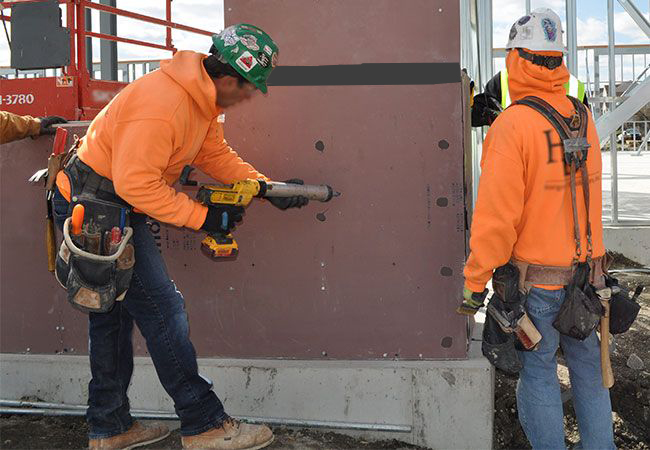DuPont™ LiquidArmor™ FJ Flashing and Joint Compound
Vapor-Permeable Flashing Material for Commercial Wall Substrates



DuPont™ LiquidArmor™ FJ Flashing and Joint Compound
Vapor-Permeable Flashing Material for Commercial Wall Substrates
<br><b>DuPont™ LiquidArmor™ FJ Flashing and Joint Compound</b> is a brush or trowel-applied, vapor-permeable elastomeric flashing material. It combines the functions of both flashing and joint compound into a single unique product that is an integral part of the <b>DuPont™ ArmorWall™ System</b>.
Features & Benefits
Specifications
Standard Sizes
| Unit | Unit Size | Units per Case | Cases per Pallet | Units per Pallet |
|---|---|---|---|---|
| Sausage | 20 oz | 16 | 50 | 800 |
Testing
<b>DuPont™ LiquidArmor™ FJ</b> exhibits physical properties as indicated when tested as represented. Review all instructions and (Material) Safety Data Sheet ((M)SDS) before use. Please contact DuPont at 1-833-338-7668 when additional guidance is required for writing specifications that include this product
| TEST METHOD | TEST TITLE | PROPERTY | RESULTS |
|---|---|---|---|
| STRENGTH | |||
| ASTM D412 | Standard Test Methods for Vulcanized Rubber and Thermoplastic Elastomers—Tension | Tensile | 215 psi |
| ASTM D412 | Standard Test Methods for Vulcanized Rubber and Thermoplastic Elastomers—Tension | Elongation at Break | 400% |
| ASTM D412 | Standard Test Methods for Vulcanized Rubber and Thermoplastic Elastomers—Tension | Recovery (held at 300% elongation) | >92% |
| ASTM D2240 | Standard Test Method for Rubber Property—Durometer Hardness | Hardness | 69 Shore A |
| ADHESION | |||
| ASTM D4541 | Standard Test Method for Pull-Off Strength of Coatings Using Portable Adhesion Testers | Adhesion Strength - Exterior Gypsum | Delaminates fiberglass topsheet |
| ASTM D903 | Standard Test Method for Peel or Stripping Strength of Adhesive Bonds | Peel Strength | 19 lbf/in (aluminum) Cohesive Failure |
| ASTM C794 | Standard Test Method for Adhesion-in-Peel of Elastomeric Joint Sealants | Adhesion-in-Peel | 19.5 lbf/in (mortar) |
| FIRE | |||
| NFPA 285 | Standard Fire Test Method for Evaluation of Fire Propagation Characteristics of Exterior Wall Assemblies Containing Combustible Components | Flame Propagation | PASS Multiple Assemblies |
| AIR | |||
| ASTM 2178 | Standard Test Method for Determining Air Leakage Rate and Calculation of Air Permeance of Building Materials | Air Penetration Resistance | 0.0002 cfm/ft2 @ 75 Pa (1.57 psf) |
| Tappi T-460 | Air resistance of paper (Gurley method), Test Method | Air Penetration Resistance | >10,000 sec/100 cc |
| ASTM E2357 | Standard Test Method for Determining Air Leakage Rate of Air Barrier Assemblies | Wall Assembly Air Penetration Resistance | <0.04 cfm/ft2 @ 75 Pa |
| ASTM E283 | Standard Test Method for Determining Rate of Air Leakage Through Exterior Windows, Skylights, Curtain Walls, and Doors Under Specified Pressure Differences Across the Specimen | Wall Assembly Air Penetration Resistance | <0.04 cfm/ft2 @ 75 Pa |
| WATER | |||
| AATCC 127 | Test Method for Water Resistance: Hydrostatic Pressure | Water Penetration Resistance | >1000 cm |
| ASTM E96 | Standard Test Methods for Gravimetric Determination of Water Vapor Transmission Rate of Materials | Water Vapor Transmission | 14 @ 35 mils Method B perms |
| ASTM E331 | Standard Test Method for Water Penetration of Exterior Windows, Skylights, Doors, and Curtain Walls by Uniform Static Air Pressure Difference | Wall Assembly Water Penetration Resistance | No leakage Tested to 15 psf |
| GENERAL | |||
| AAMA 714 | Specification for Liquid Applied Flashing Used to Create a Water-Resistive Seal Around Exterior Wall Openings in Buildings | Liquid Flashing Requirements | PASS |
| ASTM D1970 | Standard Specification for Self-Adhering Polymer Modified Bituminous Sheet Materials Used as Steep Roofing Underlayment for Ice Dam Protection | Nail Sealability | PASS No leakage |
| ASTM C1305 | Standard Test Method for Crack Bridging Ability of Liquid-Applied Waterproofing Membrane | Low Temperature Crack Bridging | PASS No cracking at 30 mil thickness |
| ASTM C1250 | Standard Test Method for Nonvolatile Content of Cold Liquid-Applied Elastomeric Waterproofing Membranes | VOC | <2 % (by wt.) 25-30 g/L |
| ASTM G155 | Standard Practice for Operating Xenon Arc Lamp Apparatus for Exposure of Materials | Ultraviolet Light Exposure (UV) | 9 months, no change |
NOTE:- Test results shown represent averages. Individual results may vary either above or below averages due to normal manufacturing variations, while continuing to meet product specifications.
